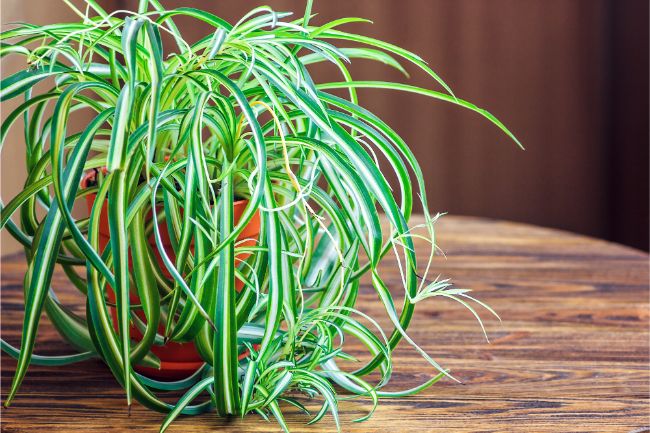The Spider Plant (Chlorophytum Comosum), also known as Ribbon Plant and Spider Ivy, is a popular perennial flowering plant. This plant is considered a highly-adaptable houseplant and grows easily with minimal care. The Spider Plant thrives in various conditions and is not prone to many health issues, except for brown tips, which seem to be quite common.
Why does my spider plant have brown tips? It is common for a Spider Plant to get brown leaf tips, but it can usually be prevented with correct care. Below are a few of the possible causes:
- Water stress from overwatering or underwatering
- Low humidity levels
- Fluoride content in water
- Salt build up from over fertilizing
- Too much sun exposure
If you notice brown tips on your Spider Plant, there is no need to worry too much. This is not particularly harmful to the plant, although it can ruin the plant’s aesthetics. This article takes a closer look at each of the possible reasons for brown tips on Spider Plants and discusses what you can to do fix the problem and avoid it in the future.
Reasons Why Your Spider Plant’s Tips Are Turning Brown
Aesthetics is one of the main reasons why so many people notice and want to quickly respond to brown tips on their Spider Plant. The long leaves of the Spider Plant can grow up to 16 inches in length and are typically yellow, cream, white, and green in color. The foliage is lovely to look at, but can be ruined by the appearance of brown leaf tips.
What can be done?
You can fix the problem of browning tips on your Spider Plant if you understand the reason behind it. Once you know what the underlying cause is, you can work on adjusting your care routine and implementing a strategy to avoid similar problems in the future.
The below serves as an explanation and guide to getting rid of unsightly brown leaf tips and taking better care of your Spider Plant.
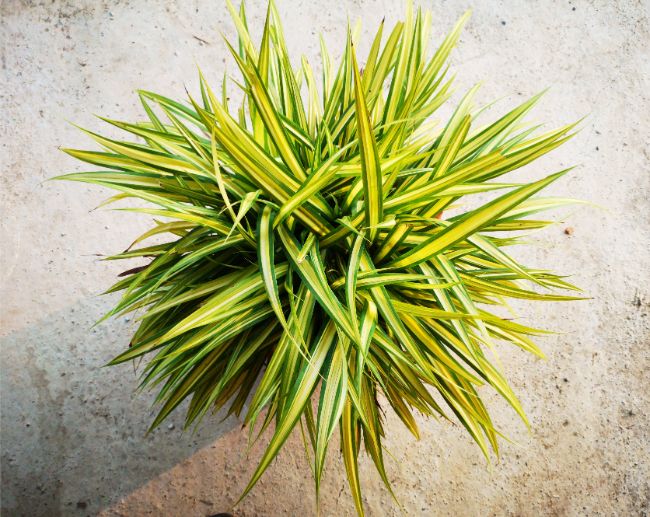
1. Fluoride Content In Water Causes Spider Plant Tips To Turn Brown
Did you know that fluoride can be toxic to plants over the long term? Often, brown leaf tips on the Spider Plant is the result of added fluoride in the water.
Domestic water supplies often contain significantly different fluoride content. Some water supplies naturally contain higher levels of fluoride, whilst some water authorities put fluoride into water to help prevent tooth decay.
It is a good idea to check your water supply to see if the problem is fluoride-related. Most water authorities produce regular water quality reports which can be accessed online or by request. This can provide really interesting information about the health of your water supply for your plants and also for you and your family.
You can also take a sample of your own water and either test it at home or send it to a water testing company, who will tell you exactly what is in your water.
Normal levels of fluoride in water will not harm a plant, but if you water your plant with tap water that has added fluoride continuously, it can build up in the plant.
Your Spider Plant will not get brown tips immediately from fluoride in the water. Over time, the fluoride builds up inside the plant and when it reaches a certain level, it starts to negatively impact the health of the plant.
Fluoride inhibits the process of photosynthesis and can damage some of the plant’s tissues too. Fluoride moves through the plant with water and to the stomata on the leaves. It eventually causes toxicity to the outer edges of leaves and causes them to turn brown. While this will not kill the plant quickly, it can really spoil the look of your plant.
How To Fix Browning Tips From Fluoride In The Water
If you suspect that the fluoride content in the water is responsible for your Spider Plant’s leaf tips turning brown, you can fix the problem and avoid it in future fairly easily.
First off, you can leach the plant from time to time by thoroughly flushing the soil out with distilled water or rainwater. You will need to do this on more than just one occasion if you want to help the plant return to a balanced state.
How do you flush or leach a plant’s soil? The process is fairly simple. To do this, pour a few jugs of water into the house plant’s pot and give it a few minutes to drain out. Immediately repeat the process and let it drain out again. You can also try using a different water source for watering your Spider Plant.
A good idea is to start collecting rain water for watering plants or to use distilled water for plant watering. The Spider Plant doesn’t require too much water, so distilled water should not cost too much to keep your plant happy.
Using a soil medium with high calcium levels can also help prevent fluoride toxicity, as it can reduce the uptake of fluoride into the plant and therefore reduce the chance of injury to the plant.
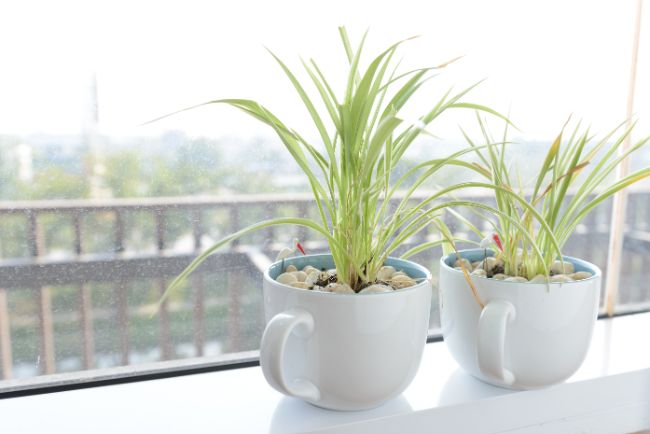
2. Water Stress Causes Brown Leaf Tips On Spider Plants
Your Spider Plant could be presenting brown leaf tips from water stress. Water
stress refers to both overwatering and underwatering, so make sure to
investigate which it is before taking any sort of action.
If you are prone to overwatering, it will certainly lead to the leaf tips turning brown. Why does this happen? Overwatering often leads to root rot. Root rot stops the flow of water and nutrients to the leaves and rest of the plant, which can result in the leaves turning brown at the tips and eventually dying, if the problem is not tended to.
Another water stress problem is that of underwatering the plant or not enough water getting to the leaves.This doesn’t always mean that you haven’t given the plant enough water. This can happen if you move the plant near a heat source and it inadvertently dries out.
Underwatering your Spider Plant can result in the leaves drying out slowly. While the Spider Plant likes the soil to mostly dry out between watering, it should not be allowed to dry out completely. If it lacks moisture, the leaves are the first to show it. And it shows it with browning tips.
How To Fix/Stop Browning Tips From Water Stress
If you suspect that your Spider Plant’s leaves are turning brown from over or under watering, you will need to adjust your watering technique and frequency immediately.
Only water the Spider Plant when the soil is almost dry (do not let it become too dry though). An underwatered Spider Plant will usually bounce back to health once it is sufficiently watered and given time to readjust again.
An overwatered Spider Plant is a different story. It can require more work to get it back to health. The possibility of it bouncing back depends on the amount of damage that the plant has suffered. If the root rot is not too severe, the affected areas can be removed (cut off) and the plant may revive.
In most instances, simply removing it from the over-wet environment will do the trick. Also, you should never leave your house plant standing in water after watering it. Ensure that the pot has sufficient draining holes and that the soil does not trap water.
Once you have watered the plant, wait 30 minutes and then empty the drip tray to ensure there is no excess water being absorbed into the soil and root system.
I’ve got a really useful guide to help you know when your indoor plants need watered. It’s one of the most tricky things to master when caring for your indoor plants, so it’s well worth learning how to get it right. Read my article here.
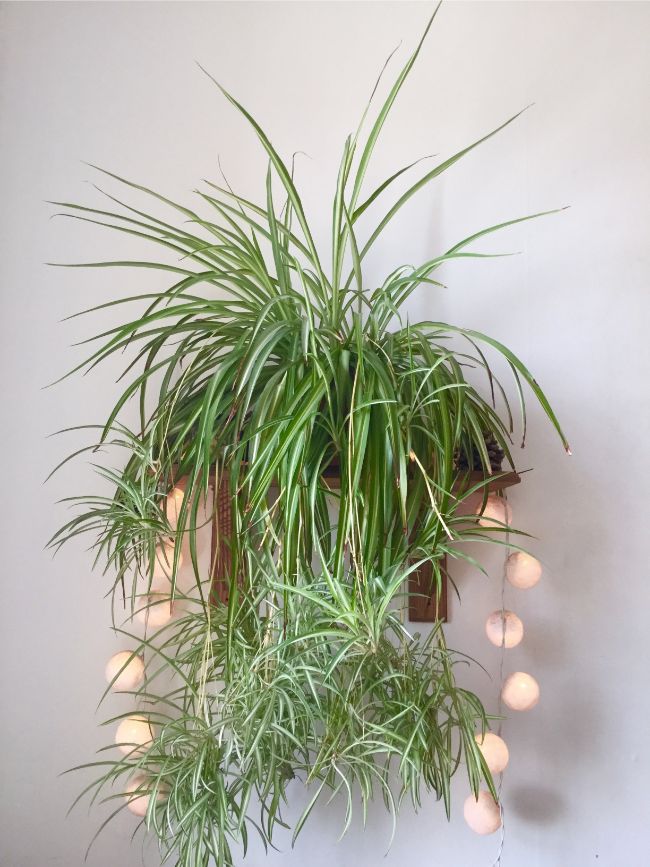
3. Low Humidity Levels Can Cause Your Spider Plant To Get Brown Leaf Tips
The Spider Plant requires high humidity levels in order to thrive. In low humidity environments the leaf tips tend to dry out and turn brown. While the Spider Plant makes for a good indoor plant, it often shows signs of unhappiness in winter when the humidity levels in most homes is too low for its liking. The best way to keep your Spider Plant happy is to place it in a room with high humidity levels.
How To Fix Leaf Tip Browning From Low Humidity Levels
During summer, you can keep humidity levels healthy by watering the plant on time, grouping it with other plants, or using a humidity tray. During winter, you can position a humidifier near (or in the same room) as your Spider Plants to keep moisture levels in the air up. I’ve written a really useful article which explains how to get the perfect humidity levels for your indoor plants.
4. Fertilizer Build Up Can Result In Spider Plant Leaf Tips Turning Brown
If your Spider Plant starts developing brown leaf tips, it could be a case of fertilizer salt build up. Fertilizer build up can cause a house plant to show signs of distress. Providing too much fertilizer for houseplants will result in toxicity to your plant, which often presents as brown leaf tips in Spider Plants.
The fertilizer build-up can cause damage to the Spider Plant’s roots too, which in turn reduces absorption of water and nutrients to the rest of the plant. As the leaves do not receive the nutrition they need, they can start to dry out and turn brown on the tips.
How To Fix Brown Leaf Tips Caused By Over Fertilizing
If you think that your Spider Plant’s leaf tips are browning due to over fertilizing, there are various things that you can do to fix the over fertilizing problem and prevent the same problem from happening in the future.
A popular way to fix the problem is to repot the house plant in fresh, quick draining soil. You can also cease fertilizing and proceed to flush the soil by pouring a few liters of water through it. Start by completely drenching the soil. Once it has drained out, drench it again, and repeat. This should flush a large amount of salt build up from the soil and it should start returning to a more balanced state.
A Spider Plant only needs to be fertilized during the growing season and not more than once every 3 months. A balanced, water soluble, indoor plant fertilizer will be suitable. Alternatively, you may wish to explore natural options for fertilizing your Spider Plant. I’ve covered the options to fertilize indoor plants naturally in this article.
Whenever preparing the ferilizer, only make it up at half the recommended strength. The reason for this is that plants living indoors typically grow more slowly than those grown outside, so their nutrient needs are lower. By reducing be half, you reduce the risk of nutrient toxicity and will help to keep your Spider Plant thriving.
5. Too Much Sun Exposure Can Cause Brown Leaf Tips.
As Spider Plants like shady spots and even moisture, it comes as no surprise that they do not like to get too hot or too dry. This rules out spending all day exposed to the sun. Place your Spider Plant in bright to moderate light, but not direct sunlight, and it will thrive happily for many years.
Direct sunlight is overwhelming for the Spider Plant as it usually burns its leaves. Over exposure to the sun causes brown tips and brown spots on the leaves.
How To Fix Brown Tips From Too Much Sunlight
If your house plant is positioned in a sunny spot and is starting to show browning tips, it could very well be the sunlight that is causing leaf burn. To save the plant, move it into a shady spot and monitor how it does thereafter. When it comes to positioning, a spot that has bright light is fine, but no direct sunlight is required.
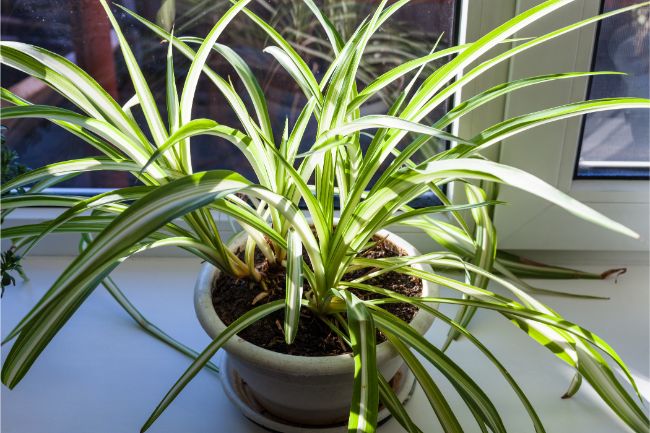
Can I Cut The Brown Tips Off My Spider Plant?
When your Spider Plant starts presenting brown tips and you figure out what the problem is, you might want to spruce the plant up while it recovers. There is nothing less aesthetically appealing than a plant with brown or dried out leaves, but what can you do? Should you cut the tips off the Spider Plant’s leaves, or are there better ways to spruce up the plant?
The best way to spruce up your Spider Plant is to cut off the leaves that have brown tips. Alternatively, you can pull the leaf out of the plant completely. If you just wish to snip the tips off, that is also a good idea. Use a sharp pair of scissors and ensure you clean the scissors with rubbing alcohol before and after using them to avoid spreading disease.
The tips of the Spider Plant leaves are sharp and pointed. To minimize the appearance of cut leaves, you can snip the tips off at an angle, to look just like the natural angle of the leaves – no one will even know that your Spider Plant had brown tips in the first place.
Keeping The Spider Plant Free From Brown Tips
Now that you have spruced up your Spider Plant, you need to ensure that the problem causing the brown tips to start with, does not continue. Make sure that you take care to implement the following care techniques:
Consistent Watering Guided By The Plant’s Needs
The Spider Plant should only be watered again when the soil is almost dry. Remember to feel the soil dryness before watering to ensure that you are not watering too soon or leaving it too long.
One of the most important skills to master is to be able to assess when your indoor plants needs more water. Watering problems are so common and it can be tricky to know when to water your plants without knowing exactly what to look for. I’ve written an article which will show you exactly how to know when your houseplants need water and prevent overwatering or underwatering.
Provide The Plant With Sufficient Sunlight
Spider Plants growing outdoors like to grow in partial to full shade areas. Inside the home, they do not need direct sunlight, but do require bright, indirect light. Take the time to observe your Spider Plant over the space of a few weeks to determine whether you have it in the right spot.
Adjust Your Fertilizing Schedule
The Spider Plant does not need a lot of fertilizer. You can fertilize the plant every 2-3 months in the growing season with a weak water soluble plant food solution. If there is a build up in the soil, flush the soil thoroughly with water or repot as appropriate.
Use Fluoride-Free Water For Your Spider Plants
Check with your local council about the contents of your water. If your tap water has added fluoride, consider watering your plant with water from a different water source.
Last Word
Caring for your Spider Plant is all about creating a stable environment for it. If it is kept out of direct sun, given enough water and humidity it will thrive and flourish for many years. Spider plants aren’t too hard to look after and the more you observe and get to know your plant, the better you will become at noticing and fixing any problems.
I’ve written another few articles which cover common problems with spider plants and how to deal with them. I’ve written an article to help you if your spider plant is dying and you can’t work out why and another on how to fix yellow leaves on spider plants.

